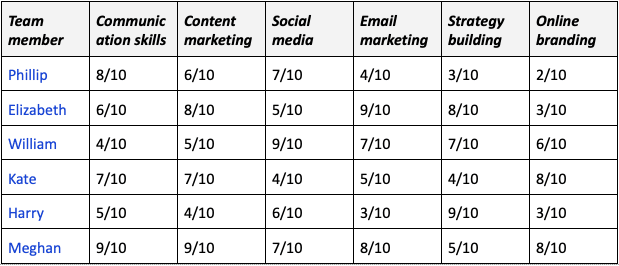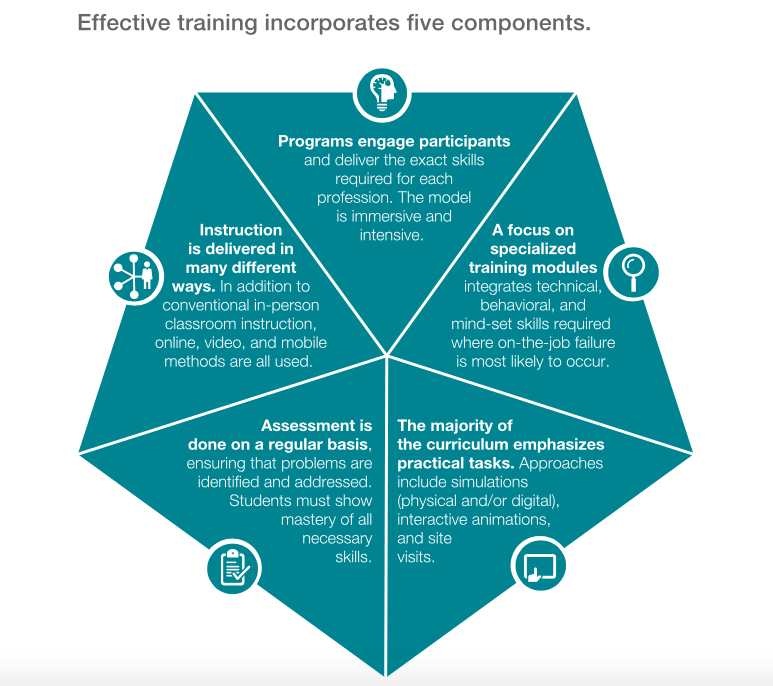
Winston Churchill once famously said, "Personally, I'm always ready to learn, although I do not always like being taught." This quote got us thinking about how we humans have different learning styles and targeted training objectives.
In this digital age, learning and development have generally become more real-time, customized, contextual, and easily measurable due to technological advancements. The modern professional knows the recipe for a successful formula is ongoing learning and growth.
However, companies struggle with long-term skill development and often fail to provide their employees with the proper tools for learning. Targeted training helps companies upskill and reskill their employees in the most crucial areas to increase retention and meet the end goals.
In this article, we will outline eight steps to deploy targeted training in your company. But first, let us understand what the term actually means:
What is targeted training?
Targeted training refers to a planned set of activities that are directed towards enhancing employee skills and behaviors that the leadership requires to achieve their broader business goals.
This helps employees gain more expertise and boost their value to perform their current job or prepare to take on a more advanced job role. Targeted training allows your company to send a positive message to employees that you care about their growth and welfare.
8 steps to follow to create an effective targeted training plan
Every company understands the value of a high-quality training program. It enables greater efficiencies, better profit margins, and lower costs. However, a typical training process quickly runs employees through the motions and churns them out at the earliest.
That is precisely what targeted training is not about. It is more thorough, well-thought-out, and executed with care, leaving room for improvement. Let us explore the steps you should take to create an effective targeted training program:
1. Utilize an employee skills matrix to identify skills gaps
Simply put, an employee skills matrix maps out the skill level of employees or specific teams in a grid-based visual format. It showcases the skills that the workforce currently has and draws our attention to areas that need improvement.
Below is a tabular representation of employee skills. Every skill an employee (in a specific job role should have) is rated on a scale of 1-10.

A skills matrix reveals vital information required to build initiatives that could effectively bridge any skill gaps the team faces. It streamlines employee performance evaluation and makes learning and development more effective.
2. Assess the individual employee training requirements
Every employee in your company brings different skills and experiences to the table, which means they also have preferred ways of learning. Sure, a skills matrix helps determine the skill proficiency level of your employees, but it does not tell how they want to be trained.
Whether you have 20 people in your company, 200, or even 2000, there are multiple factors to consider for targeted training, including time constraints, learning styles, access to technology, geographical location, and so on.
While you may conduct mass training on new product launches, compliance matters, and process changes, there will be times where training will be more effective if it caters to different learning styles of employees.
Take note of what and how your employees want to learn. Use questionnaires or surveys to gather information about their preferred ways of learning.
3. Identify your organizational needs
Align your employee learning requirements to your business objectives. A skills matrix helps identify existing disparities in employee performance and the overall outcome. A data-driven reason behind an initiative helps increase its overall positive impact.
For instance, if you plan to launch a business in new geography with aggressive marketing, you need employees with solid research and strategy-building skills.
Suppose you find that particular skill to be missing in your team. In that case, your training program can be directed towards honing the skill of employees who see a career in project management and strategic initiative-building.
4. Define expected training outcomes
Training outcomes are the measurable goals employees are expected to achieve at the end of a targeted training program. The outcome influences the success or failure of your initiative since you will evaluate training based on whether your employees have reached these outcomes.
Be specific when writing down the desired outcomes. Avoid using vague words, such as "understand," "learn," or "realize." Instead, use words that highlight tangible and observable action, like "calculate," "demonstrate," or "create."
A powerful example of a training goal is: "After completing the program, you will be able to create and modify Excel files." But what would not make a difference is: "During the program, you will learn the fundamentals of Excel."
Setting specific goals can help you develop strategies for measuring the impact of a targeted upskilling program through qualitative metrics.

5. Communicate the value of training
Your employees must understand what they will be learning and why. They need to see the value behind setting aside time to learn and having a clear picture of the expected outcome.
How will training help them perform their job more efficiently? How will it better equip them for the future? Your responsibility is to authentically communicate the value of training so that they take ownership of their learning.
Weaving personalization into targeted training programs involves understanding what employees know, what they need to know, the gap between the two, and how to bridge the skill gap best. Clarifying the expected outcomes will help communicate the value of training.
Besides being transparent about the value of participating, promote any incentives the employees are eligible to earn to raise engagement. This will help in employee buy-in, which can only benefit the effectiveness of the training program even more.
6. Design your training materials
As the average person today watches, reads, and listens to an enormous amount of content online, keeping your employees engaged during the training program can sometimes be challenging. Therefore, you should create an entertaining and relatable training curriculum.
Plan your materials to put your employees in control of their learning. Include hands-on and interactive elements, allowing employees to work together. Tell stories of real-life scenarios as appropriate.
Blend several formats - slideshows, videos, and reading material (pamphlets or handouts) - for variety. Using the information gathered in the above points, formulate your training modules.
Please focus on the training needs of the employees and factor in factors such as time and budget to create a targeted training program that does not burn a hole in your pocket; yet, at the same, makes a positive impact on how employees do their jobs.
7. Determine the content formats for employee training
Different employees prefer different learning styles. Some require hands-on experience; some are visual learners, some need a mentor or coach to guide them, and so on. You see, you cannot rely on a single option for delivering training. Here are the top training formats you can opt for:
a. On-the-job training
This is a practical approach to acquiring new skills and competencies needed for a job in a real working environment. That means instead of giving employees presentations or handing them reading material, they learn about the job by actually doing it.
b. Video training
Training videos enable employees to consume information in an easy-to-understand format that helps them retain it for longer.
c. Instructor-led training
This is a traditional employee training method, typically driven by a development professional who may use a combination of instructional tools and informational materials when conducting their lessons.

This type of training is time-consuming. However, it is most helpful in helping employees grasp complicated subject matters.
d. eLearning
Also known as web-based training or online learning, eLearning helps employees learn from the comfort of their homes through live webinars, digital adoption platforms, learning management systems, and other online mediums.
e. Group training
This typically involves sessions where a larger group of employees partake in guided activities and discussions. Group training helps the participants bond and become more invested in each other's individual success. Even though this is a cost-effective option, some instructors may struggle to facilitate it because of potential discordant opinions.
8. Evaluate the effectiveness of the targeted training program
Reaching goals is impossible if you have no system in place to track and analyze the impact of your targeted training. Consider the following metrics to evaluate its effectiveness:
a. Knowledge gained
With the help of employee skills assessments, demonstrations, or quizzes, you can check how well the employees learned the material they were presented with.
b. On-the-job proficiency
Observe employees and see how they apply the new knowledge or skills acquired on the job. Has it really made a difference to their efficiency?
c. Employee feedback
Gather feedback from the participants post-training to confirm whether they liked the training and learned something new and what their overall suggestions are. Conduct an anonymous online survey to get employees to answer truthfully.
d. Business results
Analyze the results targeted training produces on a quarterly or bi-annual basis. Check whether the training influences a rise in revenue, productivity levels of employees, and any other predictors of job performance you choose to monitor.
Over to you
As the business scenario evolves rapidly, employees expect their companies to support them with informative training programs continuously, enabling them to keep up with the latest industry processes, trends, technologies, and of course, skill sets.
Different training methods help enhance skills for employees to improve their performance and productivity levels along with upskilling them to prepare for the future. Any company investing in the targeted training of employees further drives its success. Be that company!
FAQs
1. What is the employee skills matrix?
A skills matrix is a grid-based visual framework representing the skills an organization currently has access to and the skills that will be required in the future. Besides, it shows the proficiency level of every employee for each skill.
2. What is competency management?
Competency management involves identifying skills essential for an employee to have to reach the target performance levels in a specific role. It helps cultivate and optimize those skills to align with the overall business growth strategy.
3. What are the steps involved in designing a targeted training program?
Utilize an employee skills matrix to identify skills gaps. Assess the individual employee training requirements. Identify your organizational needs. Define expected training outcomes. Design the training materials that communicate the value of training. Determine the content formats for employee training. Evaluate the effectiveness of the targeted training program.

Asavari is an EiR at Adaface. She has made it her mission to help recruiters deploy candidate-friendly skill tests instead of trick-question based tests. When taking a break, she obsesses over art.
Spending too much time screening candidates?
We make it easy for you to find the best candidates in your pipeline-
with a 40 min skills test.


